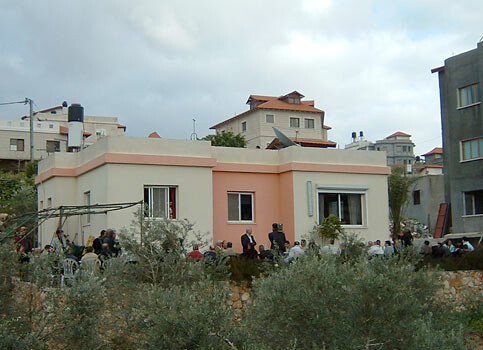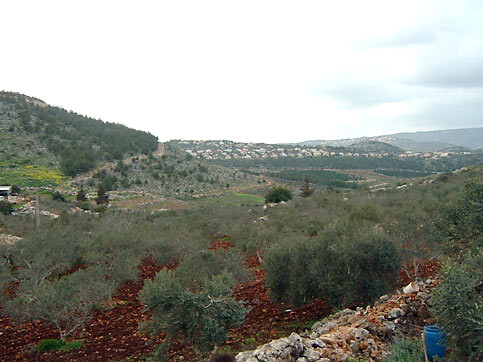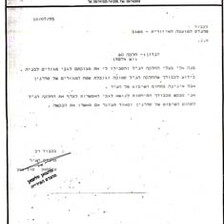The Electronic Intifada 10 March 2005

A recent protest meeting held at the home of Ali and Terese Zbeidat. Their house has been ruled illegal and threatened with demolition, despite being built on the family’s land and approved by their local municipality, Sakhnin. (Jonathan Cook)
You won’t hear about the story of my Palestinian friend Ali Zbeidat and the threatened demolition of his “illegal” home, either from the hundreds of international correspondents in Jerusalem or from the Hebrew media - not even from those remarkable Israeli journalists Amira Hass and Gideon Levy, two lone beacons inside Israel in the campaign for justice for the Palestinians.
None of them will tell you about the story of Ali’s family and the imminent physical and financial ruin of their lives by Israel, even though Ali’s plight is far from unique. There are tens of thousands of other Palestinians in the same desperate situation as Ali, living in homes Israel defines as illegal.
The problem for Ali is not just that he is Palestinian; if he were, you might learn of his story. Ali’s problem is that he is also a citizen of Israel. He belongs to a minority of one million Palestinians who fell under Israeli sovereignty during the 1948 war that founded a Jewish state on what was once the Palestinian homeland.
Another three and a half million Palestinians live close by, also under Israeli rule, in the occupied territories of the West Bank and Gaza. When their homes are destroyed by the Israeli army, their story catches the attention of international and Israeli correspondents. It is an interesting question why the media relate to the destruction by the Jewish state of one group of Palestinians’ homes and not to the other.
In terms of their identities, these two Palestinian populations are separated merely in a technical sense: the Palestinians of the area where Ali lives, the Galilee, were defeated in a war in 1948, whereas the Palestinians of the West Bank and Gaza were defeated in a war two decades later, in 1967. Both groups belong to the Palestinian people and are ruled over by a country which defines itself as a state of the Jews.
But from the point of view of the media and the international community there is a big difference between the two populations. A big legal difference. The Galilee and its Palestinian inhabitants were incorporated into Israel after 1948 with the agreement of the major world powers, whereas Gaza and the West Bank and their Palestinian inhabitants were occupied, in violation of international law.
Unlike the Palestinians of the West Bank and Gaza, Ali and the million or so other Palestinian citizens of Israel enjoy legal rights in a state hailed around the world as a democracy. Ali has an Israeli ID, an Israeli passport, and a vote in Knesset elections. His Palestinian brethren enjoy none of these rights.
The reason, therefore, why Ali’s story is not deemed worthy of coverage is because he is an Israeli citizen enjoying the protection of Israeli law. Unlike the occupied Palestinians living in the West Bank and Gaza, he has the right to make his case against the demolition order before a judge. The army cannot wreck his home at its own discretion, as it does in the West Bank and Gaza. Only the police, directed by the courts, can destroy Ali’s house. In other words, Ali has to break Israeli laws before his home can be demolished.
Squaring the circle
There is one problem with this argument. It makes a very large assumption, though one it is impossible to question anywhere in the mainstream media. It is the assumption that Israel is exactly as it describes itself: a state that is both Jewish and democratic at the same time; that the Jewish content of the state’s self-definition has no bearing on the democratic part of its definition; and that Ali, despite being Palestinian, can expect the same treatment as a Jew under Israeli law.
It might seem patently impossible for a state to be both Jewish and democratic. It appears as illogical as calling a state “white and democratic”, or “Catholic and democratic”. But that is not the view of the international community and its media. Israel, they believe, has squared the circle.
So what is the evidence that a geometric miracle has taken place in Israel? What is the evidence, for example, in Ali’s case?
Ali lives in the town of Sakhnin in the central Galilee, home to about 25,000 Palestinian citizens of Israel. In the late 1990s he decided to build a single-storey home inside the municipal boundaries of Sakhnin on land that has belonged to his family for generations. No one disputes that. He is surrounded on three sides by other legal buildings belonging to Palestinian families, and his own municipality approves of his decision to build there. Nonetheless, his home has been ruled illegal by the state and in a succession of rulings by the courts. In two months he, his Dutch wife Terese and their two teenage daughters Dina and Awda may be homeless.
The Galilee has vast tracts of undeveloped land on which to build. In fact, there has been a glut of communities springing up all over the Galilee since the early 1960s. But they have all been communities for Jews, who have been brought to the north of the country over the past several decades in what Israel calls the “Judaisation of the Galilee”: that is, the attempt by sheer force of numbers to ensure Jewish control over a traditional Palestinian area.
Ali had no choice but to build where he did. His family does not own land anywhere else. And most of the territory inside the country is not available to him. Israel has nationalised some 93 per cent of the country’s lands, by appropriating land without compensation from the four million Palestinian refugees who live in exile and by confiscating the lands of the one million Palestinians who live as citizens. This 93 per cent of Israel is out of bounds to Palestinians like Ali.

The view from Ali and Terese’s home, looking towards the exclusively Jewish community of Yuvalim, part of the Misgav regional council that wants their home destroyed. (Jonathan Cook)
For example, the newest neighbours to Sakhnin, based on land all around the town, are 17,000 Jews living in small luxury Jewish communities known in Hebrew as “mitzpim”. These mitzpim, which have extensive lands on which their inhabitants can build, are required by law to vet anyone who wishes to live inside them. Again by law, non-Jews are not entitled to apply to join these communities. So even if Ali wanted to build a home outside Sakhnin in one of these Jewish communities, by law he would not be able to do so.
But even so, couldn’t Ali at least find a legal way to build a house inside a Palestinian community or inside Sakhin? The problem again is the law. In 1965, the government passed the Planning and Building Law, which defined all the places in which Israeli citizens, Jews and Palestinians, could live. Every community’s room for expansion was circumscribed on a map of the country in the form of a blue line marked around it. Anywhere inside the blue line could be developed, anywhere outside the blue line could not.
In the case of Jewish communities, the blue lines were drawn generously to allow for future expansion. The state has also been adding new Jewish communities to its list ever since 1965.
In Palestinian communities, by contrast, the blue lines were drawn tightly around the houses that already existed in 1965, leaving no room for expansion. (In fact, Israel refused to draw blue lines around dozens of Palestinian communities that had existed before the creation of Israel, thereby “uncreating” them. Today some 100,000 Palestinians live in these “unrecognised villages”. In law all the homes in unrecognised villages are considered illegal and subject to demolition). Since 1965, no new Palestinian communities have been approved.
From Ali’s point of view, that means that not only is he refused access to Jewish communities but there are no new Palestinian communities where he might find other, legal land on which to build. Even if he moved to an existing Palestinian town or village he would find the same chronic shortage of land.
But what about building somewhere else in Sakhnin, somewhere legal in his own town? Ali is faced again by the problem of those Jewish rural communities, the mitzpim, that have been built all around his town. They were established on land confiscated from Sakhnin in the 1970s and 1980s. Today these various mitzpim, with a population of 17,000 Jews, have access to 50,000 acres, while Sakhnin’s 25,000 Palestinians must make do with a twentieth of the land, just 2,500 acres. Everyone in Sakhnin is struggling with same shortage of land for building.
Ali’s Catch-22: Misgav’s Gatekeeper Veto
So if all his other avenues are blocked off, isn’t the simplest solution for Ali to apply for a permit to build on his own land? After all, he and the tens of thousands of other Palestinian families in Israel threatened with losing their homes have broken the law because they built without a licence. He should abide by the law and then the threat of demolition would be lifted.

“Misgav is also very unique in its relations with its non-Jewish residents and neighbors. Five local Bedouin settlements have been absorbed by the regional council and are active members of the Misgav community. Misgav cooperates with the large Muslim Arab, Christian Arab, and Druze populations in the region in economic, educational, and cultural joint efforts. The region boasts the country’s first dual language (Arab-Hebrew) classroom, the first stage of an effort to build an educational system that will enable Jewish and Arab children to study together. This coexistence model is just one example of the many efforts that are being made by Misgav to achieve intercultural harmony and establish a productive dialogue between Jewish and non-Jewish Israelis.”
— from Misgav’s website
Misgav regional council says it does not want Ali building on his land, arguing that it needs green belt between Sakhnin and its own Jewish communities. Misgav’s officials have not been persuaded by the argument that Ali’s house does not move Sakhnin’s boundaries any closer to Misgav. As we’ve already noted, Ali’s house is surrounded by other Sakhnin homes on three sides.
Misgav’s real reasoning is not too difficult to discern. It is not a disinterested party after all. It was created as part of the government’s Judaisation policy, the drive to take land from Palestinian citizens and pass it to Jewish citizens. Misgav is insisting that Ali’s home be demolished, that his life savings invested in his home be destroyed, as part of general government measures to ensure that Palestinians lose ever more land and Jews gain it. (And to add insult to injury, Misgav can use Israeli law to force Ali to pay the charges incurred in the demolition of his home.)
As a result, Misgav has been hounding Ali through the courts for six years to get the demolition verdict it wants.
Unlike the Palestinians of the West Bank and Gaza, Ali at least has the Israeli courts he can turn to for protection. What have the judges told him? They have given him a little breathing space to see the error of his ways and get a building permit. They have ordered him to pay repeated fines of several thousand dollars while he applies for the permit. And who is authorised to issue such a permit? Misgav regional council.
Last month at an appeal court hearing in Haifa a judge ordered Ali to pay a $3,500 fine and to obtain a permit from Misgav for his house within three months. If he fails to get the permit, his home can be demolished. Who brought the appeal? Misgav council, which was unhappy at a previous court decision in October which fined Ali “only” $1,500 and gave him three years to get a permit.
What are Ali’s chances of getting such a permit? Zero. Misgav has insisted it will not issue such a permit to Ali or other “lawbreakers” because it wants the land on which their houses stand for its own (Jewish) constitutents. So Ali, like tens of thousands of other Palestinian citizens, finds himself the prisoner of a circle masquerading as a square.
Jonathan Cook is a journalist whose work has appeared in the Guardian, International Herald Tribune, Al-Ahram Weekly, and other newspapers. Based in Nazareth, Cook is an occasional contributor to EI. He is currently writing a book on the Palestinian citizens of Israel.




